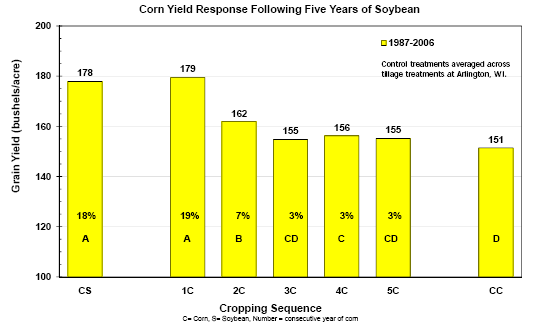
December 2007
Field Crops 28.426-51
Continuous Corn, or Rotate in 2008?
The Principle of Crop Rotation
Joe Lauer, Corn Agronomist
PDF Version
Crop rotation is a universal management practice that has been recognized and exploited
for centuries and is a proven process that increases crop yields. In the Midwestern
U.S., a biennial rotation of corn (Zea mays L.) and soybean [Glycine max
(L.) Merr.] produces significant increases in the yields of both crops.
The mechanism for the rotation effect is unknown. One hypothesis is that one factor
causes the effect. Another hypothesis is that multiple factors cause the effect
and risk of expression depends upon the environment. Research evidence began mounting
in the 1970's, which indicated that in spite of all the management inputs a farmer
might impose, there was still a yield advantage to be obtained from rotations. These
studies showed that corn yields are usually higher when the crop is rotated with
some other crop rather than grown continuously. Yield advantages to corn from rotating
with some other crop are at least 10%. In addition, soybean yields also improved
by 10% when the crop is rotated out of a continuous pattern.
More research that is recent has shown this increase to be even greater than expected
with responses up to 19% (Figure 1). The rotation effect lasts two years increasing
corn grain yield 10 to 19% for 1C and 0 to 7% for 2C.
Some other considerations when making rotation decisions include:
-
If there is only a one-year break in the rotation then the second corn phase is
equivalent to continuous corn. At least two break years are needed to measure a
response in the second corn phase (compared to CC).
-
Adding a third crop like wheat (Triticum aestivum L.) does not increase
corn grain yield, but does improve soybean grain yield.
-
Modern corn hybrids and management practices have the same rotation response as
older hybrids and practices.
Although scientists cannot yet satisfactorily explain the rotation effect, farmers
can exploit it every year. In 2008, more acres will likely be planted to the third
year of corn. These acres will be at continuous corn yield levels regardless of
the number of break years. It will be important for growers to consider getting
back to rotating crops. It is interesting that the age-old practice of rotating
crops, which for a while was considered unnecessary, has returned to today's agriculture
with proven benefits.

Figure 1. Corn yield response to rotation following five years of soybean during
1987 to 2006 at Arlington, WI. Letters indicate statistical differences at P
< 0.05. Percentage values indicate
relative differences compared to continuous corn.